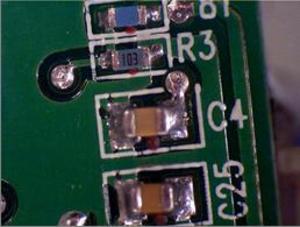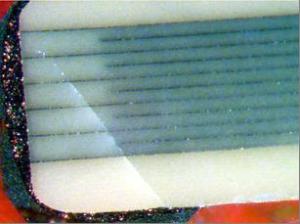Printed Circuit Board Flexing During Depanelization
Gideon Analytical Laboratories received two printed circuit boards (PCB) with the questionable failure of multilayer ceramic capacitors in the C4 position. Both these capacitors were removed from the PCB and the PCB was inspected for contamination for possible leakage current or electromigration that would account for conduction across the pad lands.
The picture at the top left is the C4. During analysis, no contamination was found on either of the PCBs or on any of the four sides of each capacitor. No visible mechanical marks and there were no discernible cracks. Both these caps were tested at 90% RH and 1V bias for 24 hours and resulted in excessive leakage current (measured with IR meter) within the cap. This indicates the capacitors have a leakage path internal to the structure.
Both capacitors were cross-sectioned to reveal plates and margin region. C4 had a crack near the terminal on one side and penetrates to about 15% of the width. This crack is visible the picture at the top right. Cracks of this nature arise from PCB flexing, especially, normal to the plane of the PCB. This results in terminal cracks. Thus, the failure is related to either handling or manufacturing. PCB flexing is the most common MLCC failure.
Failure analysis performed by Gideon Analytical Laboratories can be extremely instrumental in helping a variety of electronics companies solve problems. This information can help companies plan for the future while simultaneously saving them time and money.

MLCC caps on PCB edge

Terminal cracked caused by PCB flexing